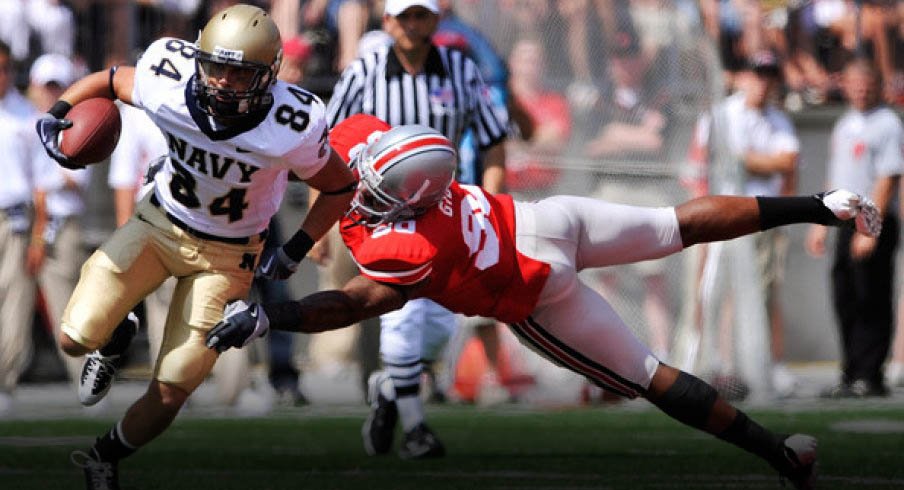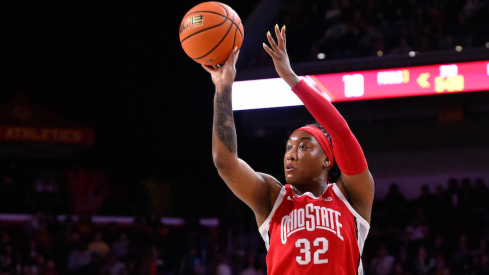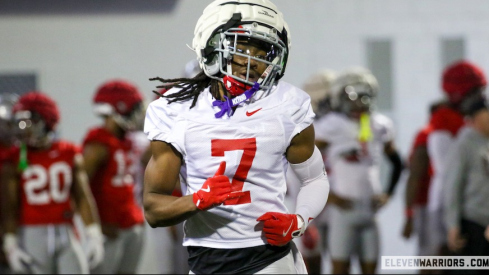Continuing our look at some of the schemes that the Buckeyes will face this fall, we'll look at how the Buckeyes will defend the trademark flexbone offense of the U.S. Naval Academy.
Last week, we broke down the basic schemes and philosophies of the Navy flexbone offense. While the flexbone system is often considered to be a “gimmick” offense, that doesn’t mean it’s any easier to defend.
With only the three service academies and Georgia Tech (led by former Navy coach, Paul Johnson) running versions of this system, teams that don’t regularly play one of those four teams can easily be overwhelmed by the many variations and adjustments that complicate what initially appears to be a simple scheme.
Since many defensive coaches at the FBS level don’t often spend time preparing for the flexbone, many answers of how to defend it can be found at the High School level, where the system is more common. However, there is no one scheme that can shut down the flexbone, and there are likely as many ideas of how to stop it as there are football coaches. There are a number of techniques and philosophies that have proven successful in stopping this option-based system though, and luckily for Chris Ash and Luke Fickell, they fit easily within the base 4-3 defense that is preferred by the Buckeyes.
Ash and Fickell can thank former Miami Hurricanes coach Jimmy Johnson for this scheme, developed to stop the wishbone option offense of then-powerhouse, Oklahoma in the early 1980s. What came out of South Florida in that time became the foundation of the 1-gap defenses used to this day by nearly every NFL and college defense.
By putting a defender in every gap, the defense can force the ball carrier to run where he doesn’t want to go. The ultimate goal of a defense when facing the triple option is to take away both the fullback dive up the middle and the quarterback keeping around the end, forcing the ball to be pitched outside where the ball is not only going backwards, but where there are (hopefully) multiple defenders and the sideline waiting.
As mentioned in part one, defending the triple option takes more than assigning one man to each potential ball carrier, as these offenses usually know how to adjust quickly to the way they’re being defended. All 11 defenders must understand the base philosophy of the scheme, and be aware of what the rest of their teammates are doing. Defenses must be prepared to adjust and play the chess match of adjustments, while still staying sound in their fundamentals to defeat a flexbone team.
One of the best examples of how to beat a good flexbone team with a 4-3 defense came from Iowa in the 2010 Orange Bowl, against Georgia Tech. With over a month to prepare, the Iowa defense was ready for everything thrown their way. Each position knew not only their responsibilities in each situation, but knew how to immediately react, thanks to countless repetitions in practice. One can surmise that Ohio State has elected to play the Naval Academy in the first game of the year for the same reason.
To better understand these responsibilities, let’s take a look at each position group and what they’ll likely be asked to do in order to stop the Navy offense.
Defensive Line
Nearly every 4-3 team that faces the flexbone will operate from an ‘Over’ front, placing the ends on the outside shoulders of the offensive tackles, the nose tackle on the weakside shoulder of the center, and the defensive tackle (often called the 3-technique) on the outside shoulder of the strongside offensive guard:
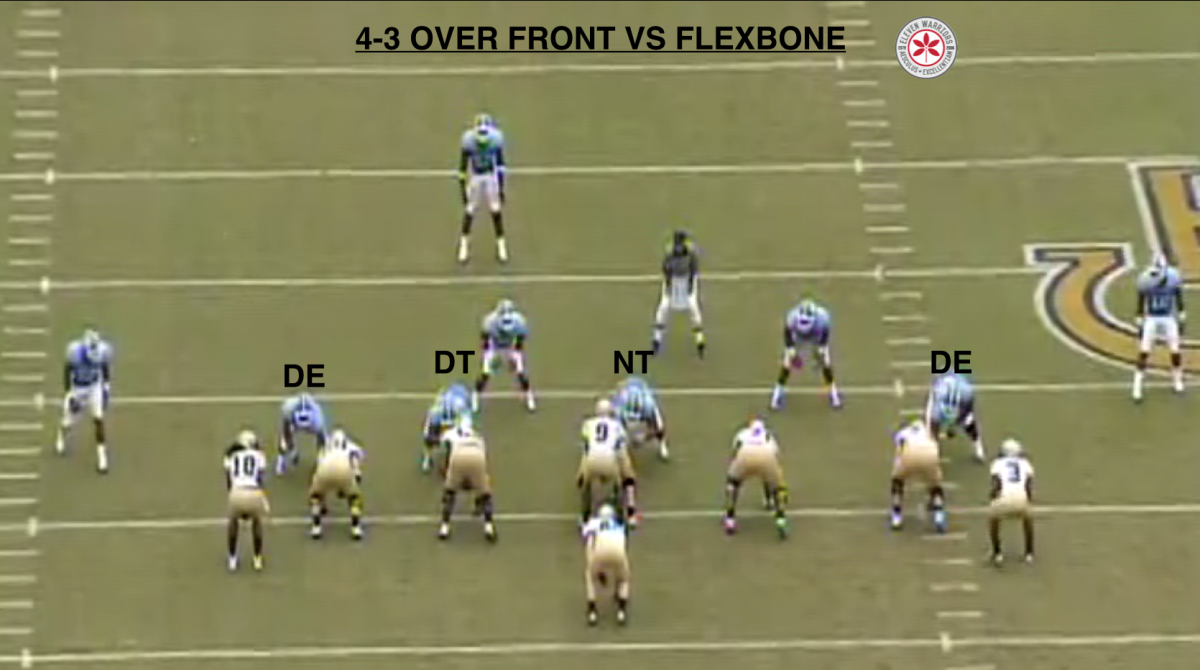
Since the base flexbone formation is often balanced from a numbers perspective toward either sideline, defenses often assign the strength of the formation to the wide side of the field. This is to try and put the 3-technique DT right in the spot to take away the B back dive up the middle on the triple option. This forces the offense to run it the other way where they are closer to the sideline and have less room to operate.
Perhaps the single most important philosophy a team must execute when facing an option team is the idea of ‘Block down-Step down’ on the defensive line. The concept has become a basic rule for 4 man lines, taught on the first day of practice and executed against nearly every offensive scheme. However, this idea alone practically ended the era of dominant option offenses in the 80s and 90s.
The basic idea is this: as a defensive lineman, if the offensive lineman across from you blocks inside, you step inside with him. The reason being that not only is there now a gap with more blockers than defenders inside, but the OL is likely going to try and eventually get upfield and block one of your linebackers. The DL is taught to keep their hands on the OL as much as possible to slow him down, while stepping into the vacated hole. When executed properly, the result is a giant mess inside for the offense:

Additionally, it’s important at all times for every member of the DL to keep his shoulders square to the line of scrimmage. Since their biggest job is to fill the gaps created by the OL, it doesn’t make sense to turn sideways and give the running back another crease through which they can run.
This is especially true when the play is going away from them, and the opposing offensive linemen are trying to ‘cut’ block them. Since defensive linemen don’t often face these kinds of blocks that often, it's common to see them forget their technique out of frustration. Flexbone teams like Navy know this, and ball carriers often look to look for the backside defenders that have now given them extra holes. A DL that is getting cut blocked must use his hands to push the blocker away from his lower body, while keeping his shoulders square to the line, and most importantly, keeping his eyes up to follow the action of the play.
Linebackers
While the defensive line often lines up in a common 4-3 Over front, the linebackers in such schemes will often line up in relatively unfamiliar spots against the flexbone.
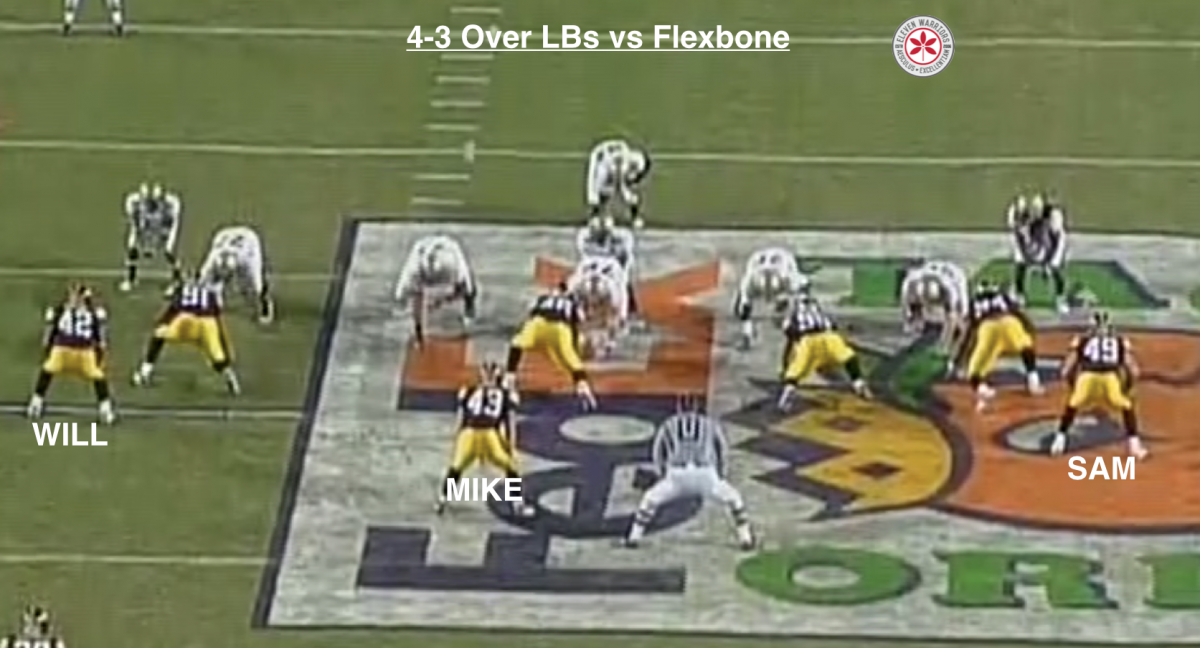
Instead of lining up in their regular spots, like a gap behind the nose tackle or on the end of the line over a tight end, the outside linebackers (SAM and WILL), line up behind either defensive end, across from the opposing A back.
The MIKE linebacker will line up either directly behind the nose tackle, but with greater depth than the other LBs. An inside LB will often line up 4-5 yards past the line of scrimmage, but against the flexbone, his alignment is usually 7 yards or so. Why? Because the MIKE is the most important player on the defense against this system.
Against the flexbone, the MIKE must be able to diagnose what kind of option is being run, the direction the ball is going, and then finally, often be there to make a tackle. Offenses know this and often try to get an offensive lineman to take him out of the play (once again showing the importance of block down-step down from the DL). The extra depth makes it that much harder for a guard or tackle to get to the MIKE, who has an athletic advantage over the blocker, and should be able to get by in a less crowded area.
Much like the DL, the outside linebackers must also know when to step into a newly vacated hole, as well as when to scrape over the top and defend the option.
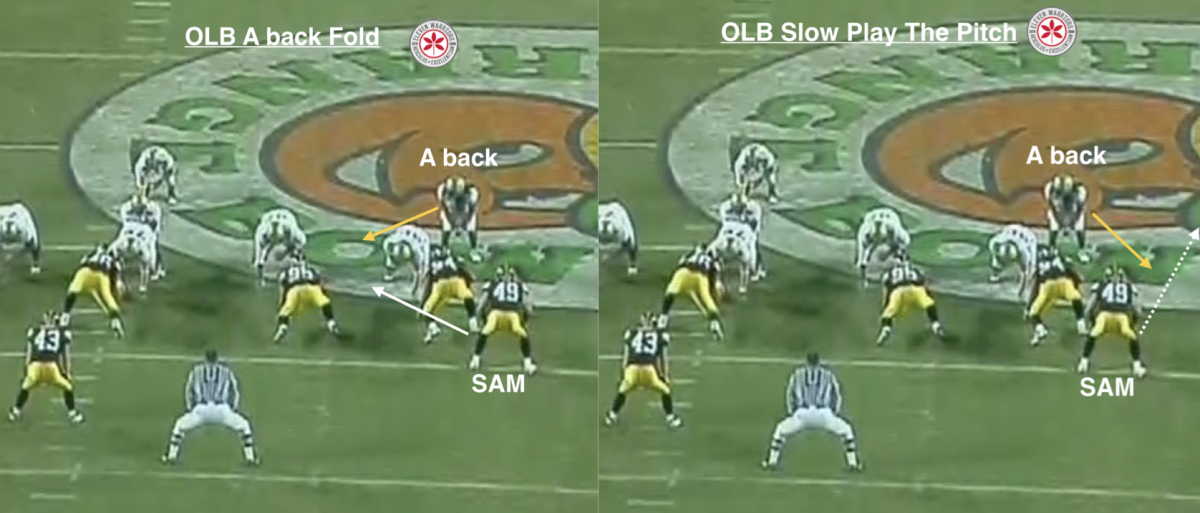
If the opposing A back folds back inside, under the tackle, he’s likely trying to block the Midline option. The OLB must recognize this and immediately step up to meet the A back in the hole. This will hopefully fill the hole and force the ball carrier to go elsewhere, as well as keep blockers off the MIKE, whose job it would be to tackle the QB on the Midline.
Against the triple option, if the OLB sees the A back release upfield or to the outside, he must step up and immediately find the QB. Thanks to block down-step down, the DE in front of him will have attacked inside, and helped take away the dive. The QB will hopefully have the ball and likely be looking to option the OLB. At that point, the OLB must not immediately attack the QB, as that will prompt an immediate pitch.
The OLB must “feather” the QB, effectively waiting for the ball-carrier to reach him. With his shoulders square to the line, the OLB keys on the inside shoulder of the QB, to make sure he can’t cut back inside. Once he can actually touch the QB, that’s when the OLB makes a tackle, hopefully right on the line of scrimmage.
If executed correctly, the OLB will have help coming from the inside with the MIKE linebacker, as well as from the outside, as one of the defensive backs will be there to take the pitch man.
If you read part one though, you know that the Navy offense won’t just let a defense run that over and over again though. They will adjust and block the OLB with multiple players, and force those keys to be wrong. To counter, defenses will often switch their keys, and send stunts with their DL and LBs, showing why it’s so important for all 11 players to understand the ‘why’ of their schemes just as much as the ‘how’ when defending the flexbone.
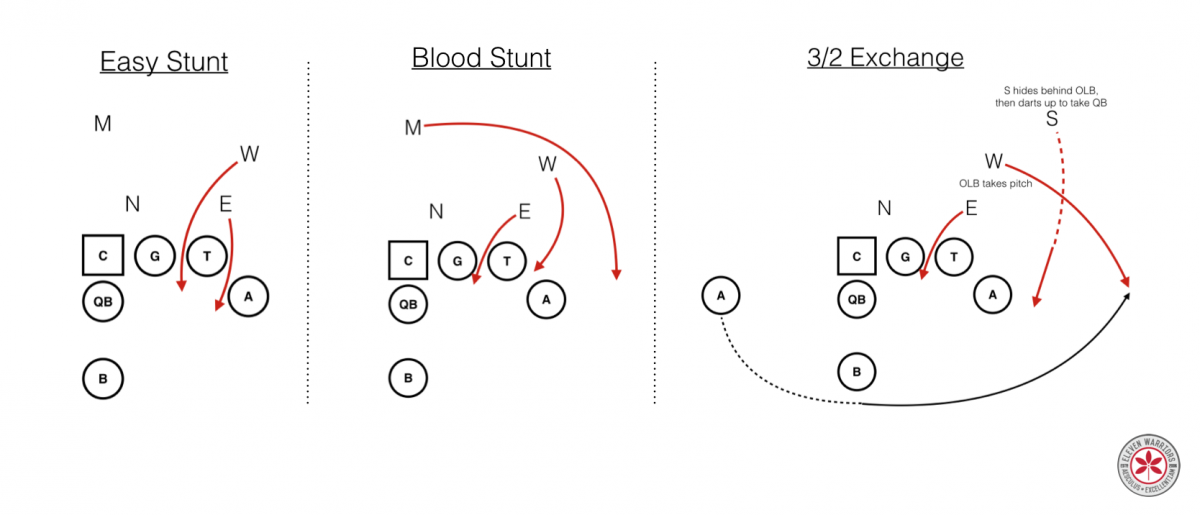
Defensive Backs
Luckily for Chris Ash, the Cover 4 scheme he was brought in to teach the OSU defensive backs fits very well with many of the philosophies we just discussed for the front seven. While they don’t do it often, Navy will throw the ball when defenses are creeping up too far to stop the run, as they did successfully against the Buckeyes in 2009. It’s important for the DBs to know the structural responsibilities of their scheme, and be able to trade with one another in a moment’s notice.
While the flexbone gives the offense four vertical threats with its initial alignment (two WRs and two A backs), the Cover 4 scheme is set up just as it sounds, giving the defense a way to cover each receiver if they were to run deep patterns. With the regular motion from an A back, the defense can roll up a safety to be the extra defender against the triple option, still keeping the other three DBs to cover the remaining three receiving threats.
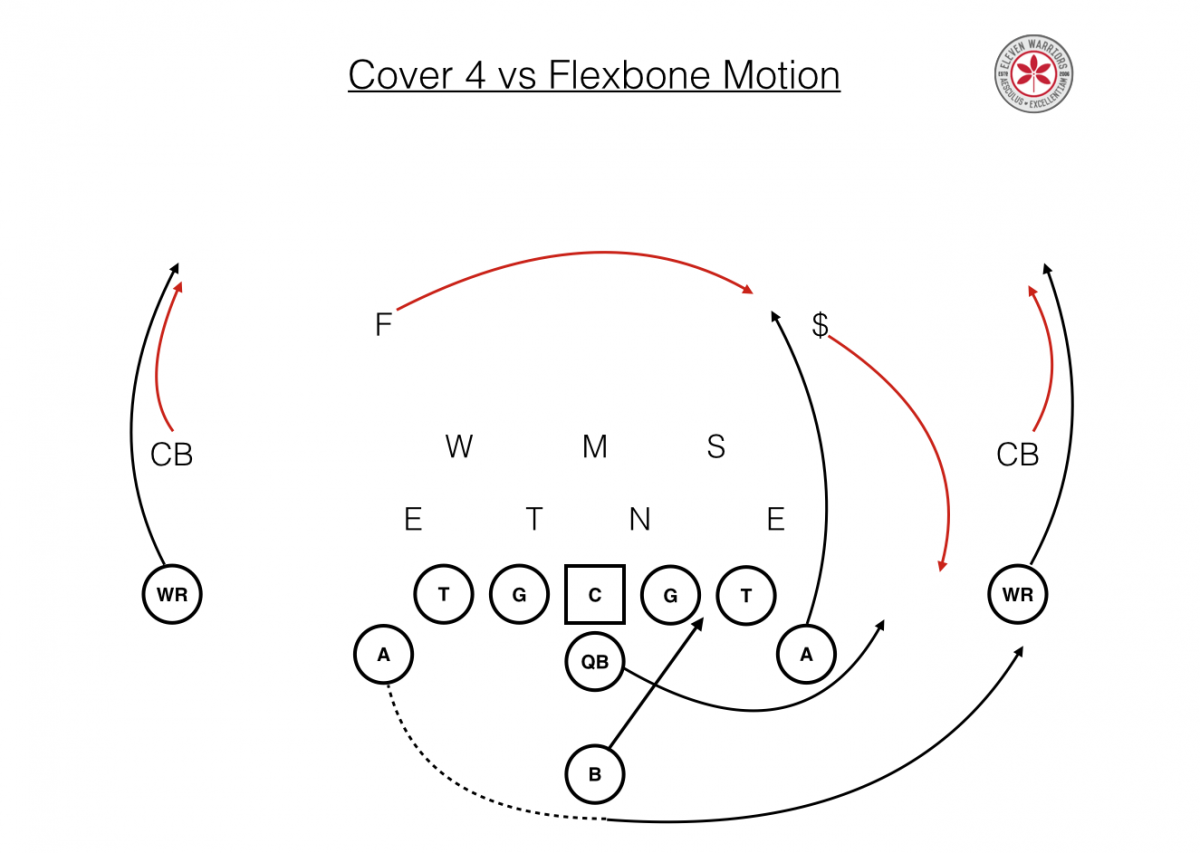
While in a regular Cover 4 scheme, the strong safety would have the #2 receiver to his side (the A back here). Since there is no #2 on the backside (the A back has gone in motion), the free safety can move over and take the playside A back on any deep pass pattern, leaving the strong safety to be a run-only defender.
But since this is a run-first offense, Navy will counter this action. The first adjustment opposing DBs will see is often the crack block delivered by the playside WR. Instead of blocking the CB lined up across from him, he’ll go back inside and try to block the safety responsible for the pitch man. In this instance, the CB must immediately recognize this action, calling out “CRACK” to alert his safety, then swapping roles and stepping up to cover the pitch.
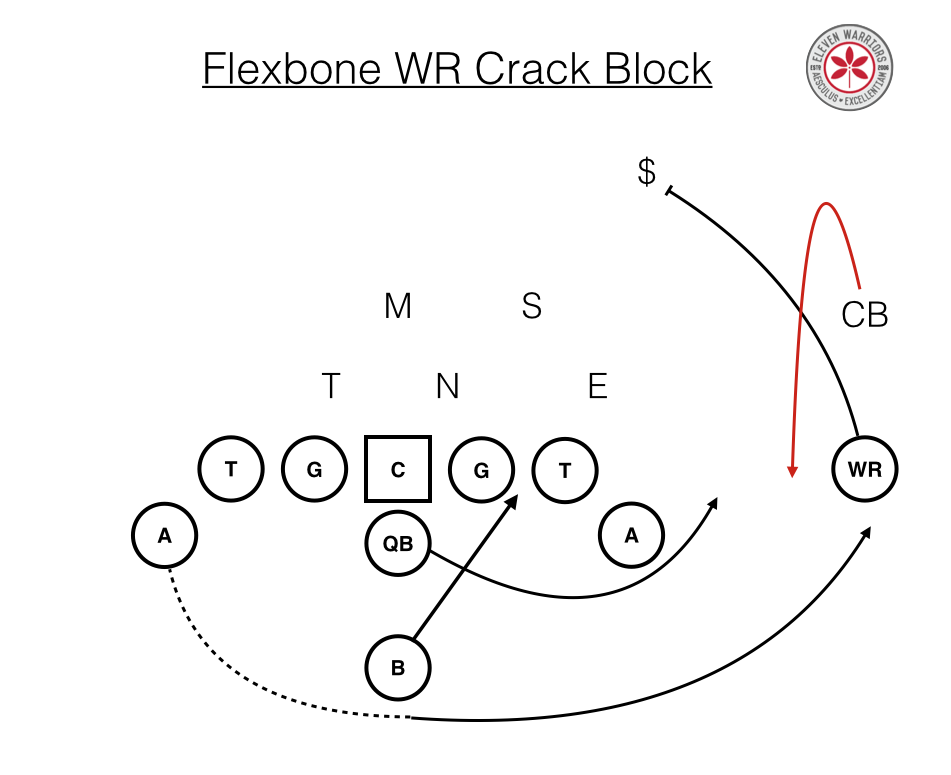
Finally, it’s critical anytime a CB is the “force” player against any kind of outside run, that they keep outside pressure on the ball carrier. They must play the runner’s outside shoulder, forcing any cuts to go back inside towards their teammates. When an offense sees that a CB can’t make a tackle in space, they’ll often run the crack block over and over, in an attempt to break a big run against the weak cornerback.
Conclusion
Playing Navy, Georgia Tech, or any flexbone team isn’t fun for a defense. Linemen get double teamed, cut blocked, and find themselves at the bottom of piles all afternoon long, all while rarely actually making many tackles. Linebackers and DBs are consistently tested mentally, seeing play after play that appears the same, yet face countless minute adjustments that, if gone unnoticed, can lead to a big play.
For those that remember the 2009 matchup in the Horseshoe, the Buckeyes handled the Midshipmen for the majority of the game, and had a 15 point lead until the 6 minute mark of the fourth quarter. It only took four plays (and an untimely OSU interception) for the Midshipmen to bring the game to a critical two-point conversion try that could’ve tied the game. Navy ran 57 plays that day, yet those four nearly took them to Overtime against the #6 team in the country.
For the Buckeyes to avoid a letdown in Baltimore on August 30th, every player that lines up in Scarlet and Gray must know not only his responsibility AND those of the other 10 guys on the field, but be ready to trade them at a moment’s notice.
